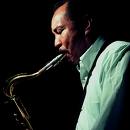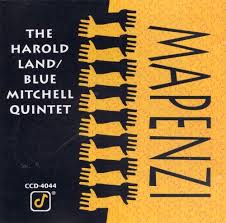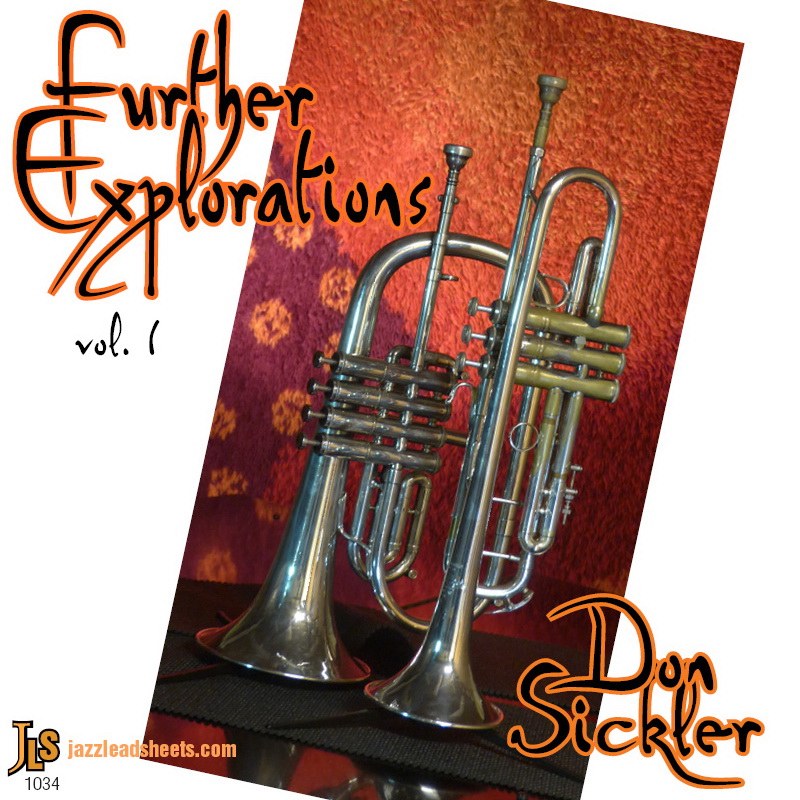Rapture – Harold Land
A lyrical Latin song without an obvious key center. We have a Minus You version in a different key.
- Recording: Harold Land - Mapenzi
- Recorded on: April 14, 1977
- Label: Concord (CJ 44)
- Concert Key: C (implied)
- Vocal Range: , to
- Style: Latin (medium)
- Trumpet - Blue Mitchell
- Tenor Sax - Harold Land
- Piano - Kirk Lightsey
- Bass - Reggie Johnson
- Drums - Albert "Tootie" Heath
Video
- Description
- Historical Notes
- Solos
- Piano Corner
- Bass Corner
- Drum Corner
- Guitar Corner
- Inside & Beyond
- Minus You
Rapture shows Harold's lyrical side, and it was one of his most requested compositions. It's a very interesting 34-measure AAB form composition [8-8-18], where the two-chord A section—four measures each of two contrasting major 7th chords—could point to one of them as being the tonal center of the composition, but not so. The B section goes in a very different direction, starting with a dominant cycle that lands in the fifth measure seemingly in F minor: is this the tonal center? Not yet. F minor is reinforced again by returning to it in the ninth measure of the B section, but then it turns and goes to E flat major before eventually ending up in C major (which we are calling the implied key). Instead of stopping there, Harold continues to add to the mystery by changing it into a dominant 7th flat 9 suspended two-measure chord that goes back to start the A section again, as a sort of "break" for the first soloist. Once you've got it together, the form is a lot of fun to solo over. Solos are on the head form; at the end of the out head, Cmaj7 is held out for four rather than two measures, followed by the bass ostinato from the intro and concluding with the first melodic phrase which ends on D♭maj7.
On this recording the bass ostinato is slightly different from the way it is on the lead sheet. The second note is on beat 2 rather than the "and" of 1. The intro is also played only once. In later versions Harold changed the rhythm and repeated the intro, as shown on our lead sheet. In this quintet arrangement the horns are voiced throughout, mostly in fourths and fifths with some thirds on the "pickup" figures.
The groove on this recording is not a bossa; Tootie Heath plays a slightly funky beat on the toms, with cymbal on beats 2 and 4. He switches to another, somewhat funky groove at the B section, with hi-hat on 1 and 3. The bass is indicated "2-feel" here on the lead sheet, but Reggie Johnson varies the rhythm quite a lot in both the B section and the solos. On later versions the ostinato is also used in the solos.
Pianists and drummers should get the Concert Condensed Score.
On this recording the bass ostinato is slightly different from the way it is on the lead sheet. The second note is on beat 2 rather than the "and" of 1. The intro is also played only once. In later versions Harold changed the rhythm and repeated the intro, as shown on our lead sheet. In this quintet arrangement the horns are voiced throughout, mostly in fourths and fifths with some thirds on the "pickup" figures.
The groove on this recording is not a bossa; Tootie Heath plays a slightly funky beat on the toms, with cymbal on beats 2 and 4. He switches to another, somewhat funky groove at the B section, with hi-hat on 1 and 3. The bass is indicated "2-feel" here on the lead sheet, but Reggie Johnson varies the rhythm quite a lot in both the B section and the solos. On later versions the ostinato is also used in the solos.
Pianists and drummers should get the Concert Condensed Score.
Harold Land later played Rapture with Art Farmer, on Farmer's 1996 "Live at Stanford Jazz Workshop." This recording also has Tootie Heath on drums; the intro is played twice as indicated on our lead sheet. Other recordings of Rapture include one by tenor saxophonist Red Holloway, on his album "In The Red" from 1997 with pianist Norman Simmons. Pianist Jon Mayer also recorded this song on his 2008 trio album "Nightscape."
Related Songs
Email Send Rapture to a friend
Send this page to a friend via email. Add your name or email in the first field. In the second, add one or more email addresses, separated by a comma.
- Recording: Don Sickler - Further Explorations Vol. 1
- Recorded on: April 4, 2003
- Label: jazzleadsheets.com (JLS 1034)
- Concert Key: G (implied)
- Vocal Range: , to
- Style: Latin (medium)
- Trumpet, Flugelhorn - Don Sickler
- Piano - Cecilia Coleman
- Bass - Tim Givens
- Drums - Vince Cherico
Video
- Description
- Historical Notes
- Solos
- Piano Corner
- Bass Corner
- Drum Corner
- Guitar Corner
- Inside & Beyond
- Minus You
Our Minus You version, rather slower than the original recording, is a fourth lower. Without a key signature this difference of key is tricky to describe; our parts label the key as G, as this is the last chord.
Don Sickler plays the melody on flugelhorn, with overdubbed accompanying muted trumpet fills on not only the in and out head but also on the first chorus of the flugelhorn solo. Meanwhile pianist Cecilia Coleman also plays fills on the A sections of the head.
Don Sickler plays the melody on flugelhorn, with overdubbed accompanying muted trumpet fills on not only the in and out head but also on the first chorus of the flugelhorn solo. Meanwhile pianist Cecilia Coleman also plays fills on the A sections of the head.
"Further Explorations" was recorded at the legendary Van Gelder Studio in Englewood Cliffs.
This was recorded by the trio in 2003, but in 2009 Don Sickler was inspired to add trumpet and flugelhorn to the basic track. Thus it became an ideal vehicle for Minus Melody, or Minus any of the rhythm section instruments. Check out the Minus You tab for details.
This was recorded by the trio in 2003, but in 2009 Don Sickler was inspired to add trumpet and flugelhorn to the basic track. Thus it became an ideal vehicle for Minus Melody, or Minus any of the rhythm section instruments. Check out the Minus You tab for details.
Exclusive Minus You audio and parts
Drummer Vince Cherico plays a simplified version of the groove from the original recording on the intro and A sections. The B section, however, has a bossa groove. Bassist Tim Givens plays with a more definite 2-feel on the B section of the head and in the solo.
clip Form of the full track:
-- intro:
time: piano and bass only
time: add drums and muted trumpet fills
-- melody: flugelhorn, with muted trumpet fills throughout and piano fills on the A sections
-- flugelhorn solo 2 choruses, with muted trumpet fills in the first chorus
-- out melody: flugelhorn, with muted trumpet fills throughout and piano fills on the A sections
-- coda: muted trumpet fills added second time, flugelhorn melody in second ending
mp3 minus melody
-- tacet for the intro
-- play the melody
-- solo 2 choruses
-- play the out melody
-- coda: tacet until second ending
mp3 minus Piano
-- count off sets up the intro
-- play the intro bass line
-- play fills and comp for the melody
-- comp for the flugelhorn solo 2 choruses
-- play fills and comp for the out melody
-- play the coda bass line
mp3 minus Bass
-- count off sets up the intro
-- play line and 2-feel for the intro and melody
-- 2-feel for the flugelhorn solo 2 choruses
-- play line and 2-feel for the out melody and coda
mp3 minus Drums (get the Piano part)
-- tacet for the intro first time
-- groove for the intro second time
-- groove and comp for the melody
-- comp for the flugelhorn solo 2 choruses
-- groove and comp for the out melody and coda
mp3 bass and drums only This bass & drums only track works great as a feature for piano, guitar, vibes or any other instrument (tenor saxophonist Sonny Rollins loved to play with just bass and drums, for example). Perfect for an audition tape.
-- tacet for the intro (optional solo second time)
-- play the melody
-- solo 2 choruses
-- play the out melody
-- coda: tacet until second ending (optional solo)
Drummer Vince Cherico plays a simplified version of the groove from the original recording on the intro and A sections. The B section, however, has a bossa groove. Bassist Tim Givens plays with a more definite 2-feel on the B section of the head and in the solo.
clip Form of the full track:
-- intro:
time: piano and bass only
time: add drums and muted trumpet fills
-- melody: flugelhorn, with muted trumpet fills throughout and piano fills on the A sections
-- flugelhorn solo 2 choruses, with muted trumpet fills in the first chorus
-- out melody: flugelhorn, with muted trumpet fills throughout and piano fills on the A sections
-- coda: muted trumpet fills added second time, flugelhorn melody in second ending
mp3 minus melody
-- tacet for the intro
-- play the melody
-- solo 2 choruses
-- play the out melody
-- coda: tacet until second ending
mp3 minus Piano
-- count off sets up the intro
-- play the intro bass line
-- play fills and comp for the melody
-- comp for the flugelhorn solo 2 choruses
-- play fills and comp for the out melody
-- play the coda bass line
mp3 minus Bass
-- count off sets up the intro
-- play line and 2-feel for the intro and melody
-- 2-feel for the flugelhorn solo 2 choruses
-- play line and 2-feel for the out melody and coda
mp3 minus Drums (get the Piano part)
-- tacet for the intro first time
-- groove for the intro second time
-- groove and comp for the melody
-- comp for the flugelhorn solo 2 choruses
-- groove and comp for the out melody and coda
mp3 bass and drums only This bass & drums only track works great as a feature for piano, guitar, vibes or any other instrument (tenor saxophonist Sonny Rollins loved to play with just bass and drums, for example). Perfect for an audition tape.
-- tacet for the intro (optional solo second time)
-- play the melody
-- solo 2 choruses
-- play the out melody
-- coda: tacet until second ending (optional solo)
Related Songs
Email Send Rapture to a friend
Send this page to a friend via email. Add your name or email in the first field. In the second, add one or more email addresses, separated by a comma.

Harold Land
February 18, 1928 – July 27, 2001
Many people only know of Harold Land as the great tenor saxophone soloist who made the classic quintet recordings with the Clifford Brown - Max Roach Quintet: Joy Spring, Daahoud, The Blues Walk and other classics—many of which are available from jazzleadsheets.com. Harold is far more than just a great tenor saxophonist sideman. Read more...
There was a problem.
...


